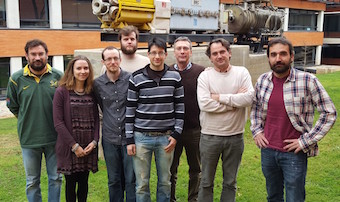
After the announcement d the detection of the first gravitational wave for the LIGO and VIRGO collaborations last 11 February, scientist propose now to search neutrinos originated by the collision which caused this gravitational wave in September 2015. To determine with exactitude the place where the event was produced, LIGO collaborated with the neutrinos telescopes IceCube and Antares, international project, this last, whose Spanish participation is leaded by the IFIC.
The detection of gravitational waves is the scientist event of the year. This milestones was realized by the experiment LIGO, that on the 14 September 2015 registered a gravitational wave produced by the collision of black holes l1,3000 light year ago. However, to determine exactly the point of the cosmos where this collision happened, LIDO needs more information. The traditional way is by using an optical telescopes network which collaborates with LIGO. But the sky can be studied by using neutrinos, not only light. This is what telescopes IceCube (in the Antarctica) y ANTARES (in the Mediterranean) do, that now publish the first results of the joint search of neutrinos came from the crash whose gravitational wave was detected by LIGO. In ANTARES has an important participation the Institute of Corpuscular Physics (IFIC, CSIC-UV).
The advantage of observing the universe with neutrinos is that this elemental particle, which almost has mass and has not electric charge, runs to us directly since it is produced almost with no interaction with the rest of the mass. So, it contains first hand information about the occurrence which has originated it, as well as the gravitational waves that now LIGO has demonstrated that can be detected. It is about two different ways to study the cosmos, which complement the astronomical observations based in light.
IceCube and ANTARES are pioneers in cosmos observation through neutrinos, known as “phantom particles” due to its difficulty to find them. Both use high amount of mass (South Pole ice or Mediterranean water) and trust that one of these neutrinos will interact. When this happens, a Cherenkov light, which can be detected by sensors, is produced. IceCube got it in 2013, by detecting neutrinos whose origin war beyond our Solar System and whose energies exceed the ones produced in particles accelerators like LHC. The sources of these neutrinos were violent events of the Universe such as supernovas or black holes collisions.
After the d the detection of the first gravitational wave for the LIGO and VIRGO collaborations, a joint study with IceCube and ANTARES is published to search neutrinos originated by the collision which caused this gravitational wave. This event, called GW150914, was produce more than 1,300 millions light years away, when two black holes with a mass 30 time bigger than de Sun one crashed and transformed a part of that mass in a space-time fold as predicted the general relativity theory of Einstein, and which is known as a “gravitational wave”.
However, LIGO (two detectors placed more than 2,000 kilometres of distance between them in United States, able to detect these minuscule changes of the order of a one ten thousand of the diameter of a proton), can not determined accurately the place where this event took place, consequently it needs a collaborator network, in optical telescopes as much as the two neutrino telescopes cited. When LIGO alerts of this detection, the telescopes point to the region sky signalled to detect other rests of the collision.
IceCube and ANTARES do not have to “point” their telescopes, since they observe all the sky continuously. They try to search simultaneous neutrinos in the gravitational wave of the event GW150914. The analysis of LIGO can only enclose the origin of this wave in a 600 square degrees (the sky has more or less 40,000 square degrees), while the precision of ANTARES or IceCube is of a square degree. However, as the three associations publish, it was not detected a occurrence number in above expectations.
To Juan de Dios Zornoza, member of the collaboration of ANTARES and KM3NeT. “neutrinos telescopes and gravitational waves detectors share the status of “newcomers” in the discovery of cosmic signals beyond the traditional photons and cosmic rays. Moreover, as the article published by LIGO/Virgo, ANTARES and IceCube describes, these new windows not only complement classical messages, but complement between them. Neutrinos telescopes observe the hole sky continuously and with a great angular resolution, which can help to localize the origin of this new event and to understood better the phenomenon. Although this correlation has not been observed in this case, this is only the beginning and we hope new gravitational waves to study “.
With ANTARES and with its successor, KM3NeT, the Institute of Corpuscular Physics leaded the Spanish participation. The research group ANTARES-KM3NeT of the IFIC has designed crucial elements in electronics of the units in optical sensors (unfolded in lines immersed in more than 3,000 metres) and in the system of temporal calibration (that reconstruct neutrinos trajectory). Physics from IFIC work in the identification of neutrinos sources and in their use as indirect search of dark matter, which form a quarter of the universe but it has not been detected yet.
More information:
http://antares.in2p3.fr/News/index.html
https://icecube.wisc.edu/news/view/398
“High-energy Neutrino follow-up search of Gravitational Wave Event GW150914 with ANTARES and IceCube”
https://dcc.ligo.org/public/0123/P1500271/013/GW150914_neutrino.pdf
Last update: 19 de february de 2016 12:00.
News release



















